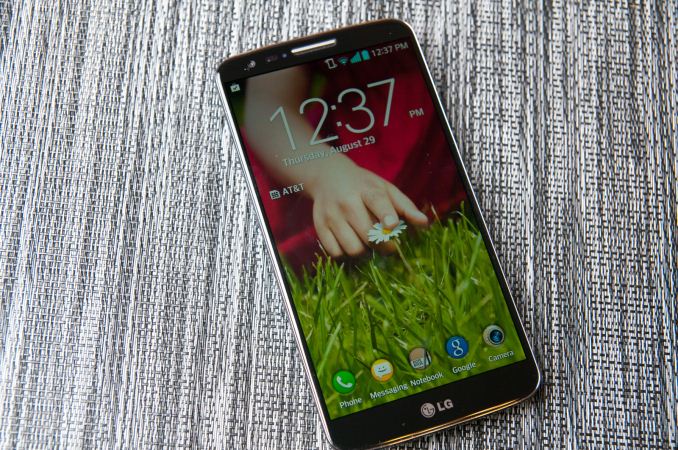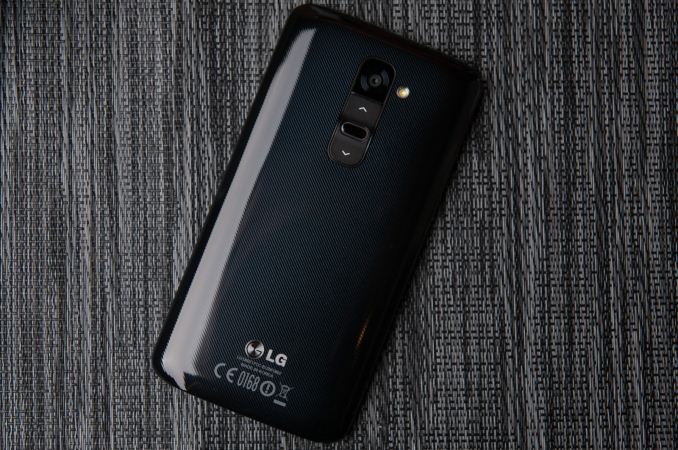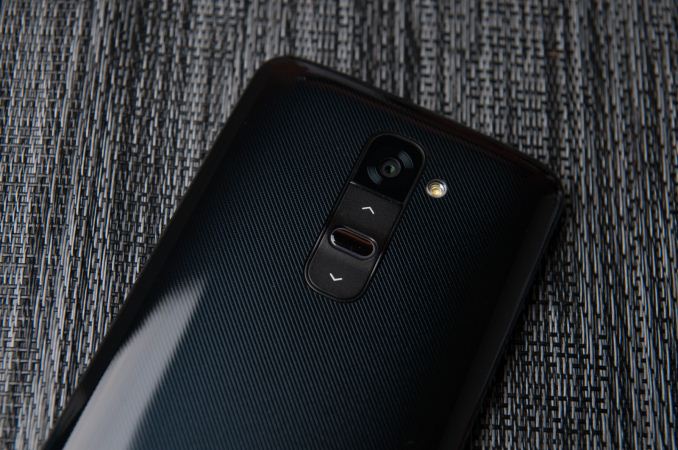LG G2 and MSM8974 Snapdragon 800 - Mini Review
by Brian Klug on September 7, 2013 1:11 AM EST- Posted in
- Smartphones
- LG
- Mobile
- LG G2
- Android 4.2
- MSM8974
- Snapdragon 800

The LG G2 is the spiritual successor to the Optimus G, a device that we looked at last year and eventually went on to become the Nexus 4. LG dropped the "Optimus" branding this time, but the G2 is without a doubt still LG's flagship smartphone, and includes a number of unique LG features – stacked 3000 mAh (11.4 Whr) battery with SiO+ anode, 5.2-inch 1080p LCD from LG Display, and 13 MP rear facing camera with OIS (Optical Image Stabilization). It's an impressive combination of features that make the G2 a standout device. At the same time the G2 is our first chance to get a look at the 2.3 GHz bin of Snapdragon 800 inside a shipping device and get a look at performance and battery life.
We took a quick look at the G2 at the announcement event, now we have our hands on a G2 and have been putting it through its paces, benchmarking it, and running battery life tests on it for a little under a week and wanted to share some thoughts.
Hardware Impressions
The G2 marries a curved backside shape with front glass that slightly curves at the edges and has a very narrow side bezel. The G2 also opts for on-screen buttons rather than the discrete capacitive kind or physical buttons that went out of favor a while ago. The reality is that Google does have a fair amount of input into at least this part of the Android ecosystem, and its guidance seems to be that on-screen buttons which use display real estate to draw the buttons is the recommended way to go. The G2 does afford the ability however to add Quick Memo buttons or the notification shade pull down/pull up buttons to the bar, but oddly enough there's no multitasking button option available.
The G2 manages to include a large display without width that's much different from other devices I've been using lately, like the HTC One. Part of getting the edge bezel small was a reduction in volume required on the sides for volume and power buttons, which are instead moved to the back of the G2, perhaps its most striking and initially even alarming design change.
Holding down the volume down button launches you into the camera, pressing the center button powers on the phone, and holding down the top button launches QuickMemo. Up and down are volume up and down otherwise. There's a hard raised lip on both sides of the button too, so the G2 when laid backside down on a surface makes contact there instead of on the button – it won't inadverntely turn on when pressed against a table. I found the backside buttons easy to adapt to after my first few interactions with the G2, and they actually become second nature after a day or so. The raised bump for the power button makes it easy to locate with the index finger, and I haven't smeared or accidentally put my finger on the sapphire camera cover yet. If the power button on the back is still difficult to get used to, the G2 has a double tap to turn on feature it calls "knock knock" – double tap on the display, and the G2 will turn on, repeat the double tap on the status bar or in an empty part of the display when it's on, and it turns off. I find myself using the double tap gesture quite a bit to turn the G2 on and off. I believe this functionality uses the sensors onboard and the DSP inside 8974 to detect when the taps occur.
The G2 I was sampled is a dark blue color which has a slight pinstripe on the back as shown in the photos above. The material is however the same kind of glossy plastic I'm used to seeing out of the Korean handset makers of note, and picks up fingerprints and hand oil very quickly unfortunately. I like the shape of the device and LG's innovations, it's just puzzling to me that materials hasn't picked up yet, I'd even take glass from the Optimus G over plastic. I'll save you the huge discussion on device size as well, I'm fine with the larger smartphones that aren't quite phablets, and the G2 for me is totally usable and I appreciate the increased display size. It definitely isn't phablet size, but it is on the larger high-end smartphone side of things.
| LG G2 | |
| SoC |
Qualcomm Snapdragon 800 (MSM8974) 4x Krait 400 2.3 GHz, Adreno 330 GPU |
| Display | 5.2-inch IPS-LCD 1920x1080 Full HD |
| RAM | 2GB LPDDR3 800 MHz |
| WiFi | 802.11a/b/g/n/ac, BT 4.0 |
| Storage | 32 GB internal |
| I/O | microUSB 2.0, 3.5mm headphone, NFC, Miracast, IR |
| OS | Android 4.2.2 |
| Battery | 3000 mAh (11.4 Whr) 3.8V stacked battery |
| Size / Mass | 138.5 x 70.9 x 9.14 mm |
| Camera |
13 MP with OIS and Flash (Rear Facing) 2.1 MP Full HD (Front Facing) |



















120 Comments
View All Comments
Crono - Saturday, September 7, 2013 - link
I'm surprised this qualifies as a "mini" review (even for AnandTech), but I'm impressed by the graphics performance of the G2 more than anything else. I'm just wondering if there are any applications or games yet that can take advantage on Android.fteoath64 - Saturday, September 7, 2013 - link
The graphics benchmarks put the Moto-X in a strong position een though it uses the older cores and newer Adreno 320 gpu. Granted it has only 1280X720 resolution, the overall performance is very close to the S800 with FullHD screens. This actually means that the Moto-X SoC is well optimized for it purposes. It also seems to beat the SGS4 in most graphics tests.Krysto - Saturday, September 7, 2013 - link
The test was done at 720p - for everyone - which means Moto X is beating most everyone else in GPU performance - at the same resolution. If you take the real world case, and put the others at their native 1080p resolution, then in the real world Moto X will be 2x better in gaming performance since it will push half the pixels.Also Adreno 320 is not new. Is a year old, just like the S4 Pro CPU cores. Just because S4 and HTC One used the same GPU this year, doesn't mean it's "new".
coolhardware - Saturday, September 7, 2013 - link
Pretty nice point!A question though, do any Android games render at a lower resolution and then upscale to fit native resolution?
Also, the LG G2 comes in about 6th place in top pixel density of phones
http://pixensity.com/list/phone/
and it has the largest screen of those top 6 phones... #7 Lenovo / #8 Sony are bigger though :-)
Looking forward to the final review and seeing LTE performance!
nerd1 - Saturday, September 7, 2013 - link
All the pixel density fad is apple's clever ploy to conceal their small screen. Resolution / size = density, so smaller screen will get higher dpi. However, it is quite obvious that if resolution is the same, larger screen is much easier on eye.FwFred - Saturday, September 7, 2013 - link
Agreed, we are well into the point of diminishing returns with PPI on high end smartphones. I'd imagine we are getting to the point where we are wasting power/performance for spec chasing.theduckofdeath - Sunday, September 8, 2013 - link
RR3 doesn't render in 1080p on the GS 4, I can clearly see pixelation in the 3D parts. I guess it might be because they're perhaps lazy in utilizing multi-core hardware? Because the game lags considerably when there are a lot of AI cars in front of you.warisz00r - Saturday, September 7, 2013 - link
If the next Nexus phone is indeed based on this, then color me very stoked.Panickd - Sunday, September 8, 2013 - link
Maybe loosely "based on". According to the FCC paperwork the Nexus 5 has a display of roughly 4.96 inches to the G2's 5.2 inches. Looking at the pictures the camera is also in a different place on both as well. Not huge differences, mind you, but seems like a lot of work going into making them different if they are indeed based on the same general design.I would plunk down for a G2 in a heartbeat if LG didn't have such a shoddy support and update record for their phones. I currently own an old G2x and am currently scanning around for it's successor. I'll have to wait to see what the Nexus 5 really turns out to be, I suppose.
Impulses - Sunday, September 8, 2013 - link
I'd take the smaller display and battery if it comes with a slightly better looking/feeling build (more Moto X and less Galaxy S).